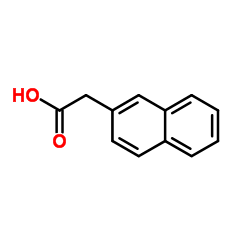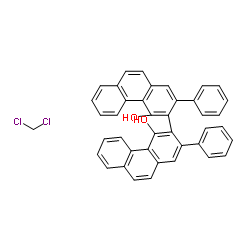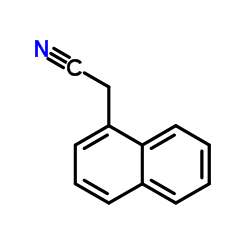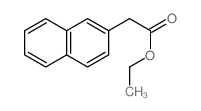37859-25-9
| Name | 2-naphthalen-2-ylacetyl chloride |
|---|---|
| Synonyms |
2-(2-naphthyl)ethanoyl chloride
2-naphth-2-ylacetyl chloride (2-naphthyl)acetic acid chloride 2-Naphthylacetyl chlotide 2-Naphthylacetyl chloride 2-Naphthaleneacetyl chloride 2-(naphthalen-2-yl)acetyl chloride Naphthalen-2-yl-acetyl chloride Naphthalen-2-ylacetyl chloride Naphthalen-2-ylacetylchlorid 2-(2-NAPHTHYL)ACETYL CHLORIDE MFCD02180524 naphthalene-2-yl-acetyl chloride |
| Density | 1.2±0.1 g/cm3 |
|---|---|
| Boiling Point | 333.7±21.0 °C at 760 mmHg |
| Melting Point | 60-61ºC |
| Molecular Formula | C12H9ClO |
| Molecular Weight | 204.652 |
| Flash Point | 156.4±15.2 °C |
| Exact Mass | 204.034195 |
| PSA | 17.07000 |
| LogP | 3.46 |
| Vapour Pressure | 0.0±0.7 mmHg at 25°C |
| Index of Refraction | 1.628 |
Synonym: Section 2 - COMPOSITION, INFORMATION ON INGREDIENTS
Risk Phrases: 34 Section 3 - HAZARDS IDENTIFICATION EMERGENCY OVERVIEW
Causes burns.Air sensitive. Potential Health Effects Eye: Causes eye burns. Skin: Causes skin burns. Ingestion: Causes gastrointestinal tract burns. Inhalation: Causes chemical burns to the respiratory tract. Chronic: Not available. Section 4 - FIRST AID MEASURES Eyes: Immediately flush eyes with plenty of water for at least 15 minutes, occasionally lifting the upper and lower eyelids. Get medical aid immediately. Skin: Get medical aid immediately. Immediately flush skin with plenty of water for at least 15 minutes while removing contaminated clothing and shoes. Ingestion: Do not induce vomiting. Get medical aid immediately. Inhalation: Get medical aid immediately. Remove from exposure and move to fresh air immediately. If not breathing, give artificial respiration. If breathing is difficult, give oxygen. Notes to Physician: Treat symptomatically and supportively. Section 5 - FIRE FIGHTING MEASURES General Information: As in any fire, wear a self-contained breathing apparatus in pressure-demand, MSHA/NIOSH (approved or equivalent), and full protective gear. Extinguishing Media: Use foam, dry chemical, or carbon dioxide. Section 6 - ACCIDENTAL RELEASE MEASURES General Information: Use proper personal protective equipment as indicated in Section 8. Spills/Leaks: Vacuum or sweep up material and place into a suitable disposal container. Section 7 - HANDLING and STORAGE Handling: Do not breathe dust, vapor, mist, or gas. Do not get in eyes, on skin, or on clothing. Use only in a chemical fume hood. Storage: Store in a cool, dry place. Store in a tightly closed container. Corrosives area. Store under an inert atmosphere. Section 8 - EXPOSURE CONTROLS, PERSONAL PROTECTION Engineering Controls: Facilities storing or utilizing this material should be equipped with an eyewash facility and a safety shower. Use adequate ventilation to keep airborne concentrations low. Exposure Limits CAS# 37859-25-9: Personal Protective Equipment Eyes: Not available. Skin: Wear appropriate protective gloves to prevent skin exposure. Clothing: Wear appropriate protective clothing to prevent skin exposure. Respirators: Follow the OSHA respirator regulations found in 29 CFR 1910.134 or European Standard EN 149. Use a NIOSH/MSHA or European Standard EN 149 approved respirator if exposure limits are exceeded or if irritation or other symptoms are experienced. Section 9 - PHYSICAL AND CHEMICAL PROPERTIES Physical State: Solid Color: beige Odor: Not available. pH: Not available. Vapor Pressure: Not available. Viscosity: Not available. Boiling Point: Not available. Freezing/Melting Point: 61 - 65 deg C Autoignition Temperature: Not available. Flash Point: Not available. Explosion Limits, lower: Not available. Explosion Limits, upper: Not available. Decomposition Temperature: Solubility in water: Specific Gravity/Density: Molecular Formula: C12H9ClO Molecular Weight: 205 Section 10 - STABILITY AND REACTIVITY Chemical Stability: Not available. Conditions to Avoid: Incompatible materials, exposure to air, exposure to moist air or water. Incompatibilities with Other Materials: Oxidizing agents, reducing agents, bases, alcohols. Hazardous Decomposition Products: Hydrogen chloride, chlorine, carbon monoxide, carbon dioxide, acrid smoke and fumes. Hazardous Polymerization: Has not been reported Section 11 - TOXICOLOGICAL INFORMATION RTECS#: CAS# 37859-25-9 unlisted. LD50/LC50: Not available. Carcinogenicity: 2-(2-Naphthyl)acetyl chloride - Not listed by ACGIH, IARC, or NTP. Section 12 - ECOLOGICAL INFORMATION Section 13 - DISPOSAL CONSIDERATIONS Dispose of in a manner consistent with federal, state, and local regulations. Section 14 - TRANSPORT INFORMATION IATA Shipping Name: CORROSIVE SOLID, ACIDIC, ORGANIC, N.O.S.* Hazard Class: 8 UN Number: 3261 Packing Group: III IMO Shipping Name: CORROSIVE SOLID, ACIDIC, ORGANIC, N.O.S. Hazard Class: 8 UN Number: 3261 Packing Group: III RID/ADR Shipping Name: CORROSIVE SOLID, ACIDIC, ORGANIC, N.O.S. Hazard Class: 8 UN Number: 3261 Packing group: III Section 15 - REGULATORY INFORMATION European/International Regulations European Labeling in Accordance with EC Directives Hazard Symbols: C Risk Phrases: R 34 Causes burns. Safety Phrases: S 26 In case of contact with eyes, rinse immediately with plenty of water and seek medical advice. S 36/37/39 Wear suitable protective clothing, gloves and eye/face protection. S 45 In case of accident or if you feel unwell, seek medical advice immediately (show the label where possible). WGK (Water Danger/Protection) CAS# 37859-25-9: No information available. Canada None of the chemicals in this product are listed on the DSL/NDSL list. CAS# 37859-25-9 is not listed on Canada's Ingredient Disclosure List. US FEDERAL TSCA CAS# 37859-25-9 is not listed on the TSCA inventory. It is for research and development use only. SECTION 16 - ADDITIONAL INFORMATION N/A |
| Hazard Codes | C: Corrosive; |
|---|---|
| Risk Phrases | R34 |
| Safety Phrases | S26-S36/37/39-S45 |
| RIDADR | UN 3261 |
|
~99% 
37859-25-9 |
| Literature: WYETH Patent: WO2006/23865 A1, 2006 ; Location in patent: Page/Page column 48-49 ; WO 2006/023865 A1 |





![1,3-dihydrobenzo[e]indol-2-one structure](https://image.chemsrc.com/caspic/081/6247-10-5.png)